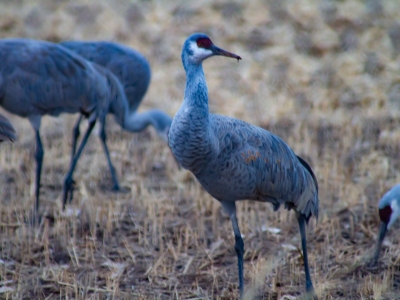The Gruiformes are an order containing a considerable number of living and extinct bird families, with a widespread geographical diversity. Gruiform means "crane-like".
Traditionally, a number of wading and terrestrial bird families that did not seem to belong to any other order were classified together as Gruiformes. These include 14 species of large cranes, about 145 species of smaller crakes and rails, as well as a variety of families comprising one to three species, such as the Heliornithidae, the limpkin, or the Psophiidae. Other birds have been placed in this order more out of necessity to place them somewhere; this has caused the expanded Gruiformes to lack distinctive apomorphies. Recent studies indicate that these "odd Gruiformes" are if at all only loosely related to the cranes, rails, and relatives ("core Gruiformes").
 Sandhill Crane
Sandhill Crane The sandhill crane (Antigone canadensis) is a species of large crane of North America and extreme northeastern Siberia. The common name of this bird refers to habitat like that at the Platte River, on the edge of Nebraska's Sandhills on the American Great Plains. Sandhill Cranes are known to hangout at the edges of bodies of water especially in the Central Florida region. The central Platte River valley in Nebraska is the most important stopover area for the nominotypical subspecies, the lesser sandhill crane (A. c. canadensis), with up to 450,000 of these birds migrating through annually.